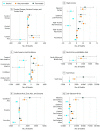Rotavirus Vaccination and the Global Burden of Rotavirus Diarrhea Among Children Younger Than 5 Years
- PMID: 30105384
- PMCID: PMC6233802
- DOI: 10.1001/jamapediatrics.2018.1960
Rotavirus Vaccination and the Global Burden of Rotavirus Diarrhea Among Children Younger Than 5 Years
Erratum in
-
Typographical Error in the Table.JAMA Pediatr. 2022 Feb 1;176(2):208. doi: 10.1001/jamapediatrics.2021.5393. JAMA Pediatr. 2022. PMID: 34870704 Free PMC article. No abstract available.
Abstract
Importance: Rotavirus infection is the global leading cause of diarrhea-associated morbidity and mortality among children younger than 5 years.
Objectives: To examine the extent of rotavirus infection among children younger than 5 years by country and the number of deaths averted because of the rotavirus vaccine.
Design, setting, and participants: This report builds on findings from the Global Burden of Disease Study 2016, a cross-sectional study that measured diarrheal diseases and their etiologic agents. Models were used to estimate burden in data-sparse locations.
Exposure: Diarrhea due to rotavirus infection.
Main outcomes and measures: Rotavirus-associated mortality and morbidity by country and year and averted deaths attributable to the rotavirus vaccine by country.
Results: Rotavirus infection was responsible for an estimated 128 500 deaths (95% uncertainty interval [UI], 104 500-155 600) among children younger than 5 years throughout the world in 2016, with 104 733 deaths occurring in sub-Saharan Africa (95% UI, 83 406-128 842). Rotavirus infection was responsible for more than 258 million episodes of diarrhea among children younger than 5 years in 2016 (95% UI, 193 million to 341 million), an incidence of 0.42 cases per child-year (95% UI, 0.30-0.53). Vaccine use is estimated to have averted more than 28 000 deaths (95% UI, 14 600-46 700) among children younger than 5 years, and expanded use of the rotavirus vaccine, particularly in sub-Saharan Africa, could have prevented approximately 20% of all deaths attributable to diarrhea among children younger than 5 years.
Conclusions and relevance: Rotavirus-associated mortality has decreased markedly over time in part because of the introduction of the rotavirus vaccine. This study suggests that prioritizing vaccine introduction and interventions to reduce diarrhea-associated morbidity and mortality is necessary in the continued global reduction of rotavirus infection.
Conflict of interest statement
Figures




References
-
- GBD Diarrhoeal Diseases Collaborators Estimates of global, regional, and national morbidity, mortality, and aetiologies of diarrhoeal diseases: a systematic analysis for the Global Burden of Disease Study 2015. Lancet Infect Dis. 2017;17(9):909-948. doi:10.1016/S1473-3099(17)30276-1 - DOI - PMC - PubMed
-
- GBD 2015 Mortality and Causes of Death Collaborators Global, regional, and national life expectancy, all-cause mortality, and cause-specific mortality for 249 causes of death, 1980-2015: a systematic analysis for the Global Burden of Disease Study 2015. Lancet. 2016;388(10053):1459-1544. doi:10.1016/S0140-6736(16)31012-1 - DOI - PMC - PubMed
-
- World Health Organization Rotavirus vaccines: an update. Wkly Epidemiol Rec. 2009;84(50):533-540. - PubMed
-
- GBD 2016 Disease and Injury Incidence and Prevalence Collaborators Global, regional, and national incidence, prevalence, and years lived with disability for 328 diseases and injuries for 195 countries, 1990-2016: a systematic analysis for the Global Burden of Disease Study 2016. Lancet. 2017;390(10100):1211-1259. doi:10.1016/S0140-6736(17)32154-2 - DOI - PMC - PubMed
Publication types
MeSH terms
Substances
Grants and funding
LinkOut - more resources
Full Text Sources
Other Literature Sources
Medical

